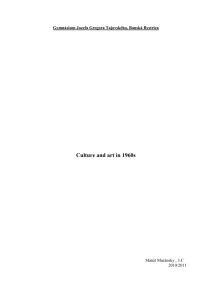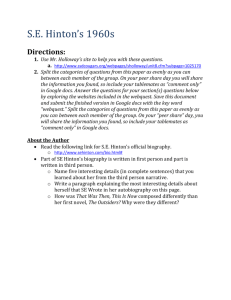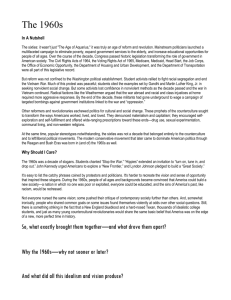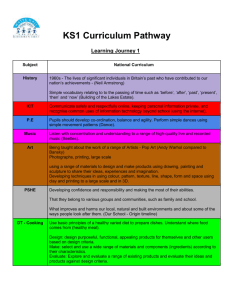Best of 1965
advertisement
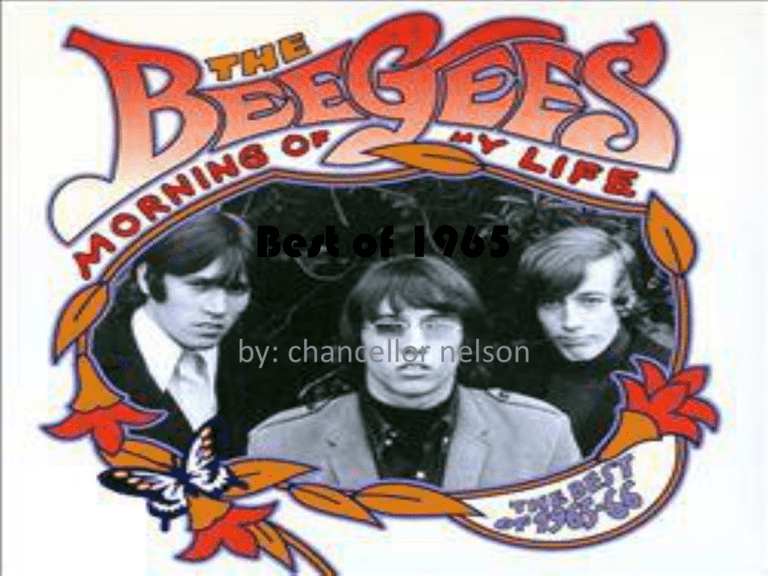
Best of 1965 by: chancellor nelson Table of contents • • • • • • • • • • 1.the Beatles 2.cars 3.music 4.president 5.death of Nat king cole 6.fashion 7life style 8.economy 9.food 10.technology The Beatles • • • The Beatles were an English rock band formed in Liverpool, in 1960. They became the most commercially successful and critically acclaimed act in the history of music.[1] Their best-known lineup consisted of John Lennon, Paul McCartney, George Harrison, and Ringo Starr. Rooted in skiffle and 1950s rock and roll, the Beatles later utilized several genres, ranging from pop ballads to psychedelic rock, often incorporating classical and other elements in innovative ways. In the early 1960s, their enormous popularity first emerged as "Beatlemania", but as their songwriting grew in sophistication, they came to be perceived by many fans and cultural observers as an embodiment of the ideals shared by the era's sociocultural revolutions. The band built their reputation playing clubs in Liverpool and Hamburg over a three-year period from 1960. Manager Brian Epstein moulded them into a professional act and producer George Martin enhanced their musical potential. They gained popularity in the United Kingdom after their first modest hit, "Love Me Do", in late 1962. They acquired the nickname the "Fab Four" as Beatlemania grew in Britain over the following year, and by early 1964 they had become international stars, leading the "British Invasion" of the United States pop market. From 1965 on, the Beatles produced what many critics consider their finest material, including the innovative and widely influential albums Rubber Soul (1965), Revolver (1966), Sgt Pepper's Lonely Hearts Club Band (1967), The Beatles (1968), and Abbey Road (1969). After their break-up in 1970, they each enjoyed successful musical careers. Lennon was shot and killed in December 1980, and Harrison died of lung cancer in November 2001. McCartney and Starr remain musically active. The Beatles have had more number-one albums on the British charts and sold more singles in the UK than any other act. According to the RIAA, they are the best-selling band in the United States, with 177 million certified units. In 2008, the group topped Billboard magazine's list of the all-time most successful "Hot 100" artists. As of 2013, they hold the record for most number-one hits on the Hot 100 chart with 20. They have received 7 Grammy Awards, an Academy Award for Best Original Song Score and 15 Ivor Novello Awards. Collectively included in Time magazine's compilation of the 20th century's 100 most influential people, the Beatles are the best-selling band in history, with EMI Records estimating sales of over one billion units. cars Muscle car is a term used to refer to a variety of high-performance automobiles.[1] The Merriam-Webster dictionary defines muscle cars as "any of a group of Americanmade 2-door sports coupes with powerful engines designed for high-performance driving."[2] A large V8 engine is fitted in a 2door, rear wheel drive, family-style mid-size or full-size car designed for four or more passengers. Sold at an affordable price, muscle cars are intended for mainly street use and occasional drag racing.[3][4][5][6] They are distinct from two-seat sports cars and expensive 2+2 GTs intended for high-speed touring and road racing. Developed simultaneously in their own markets, muscle cars also emerged from manufacturers in Australia, South Africa, the United Kingdom, and elsew Music Popular music of the United States in the 1960s became innately tied up into causes, opposing certain ideas, influenced by the sexual revolution, feminism, Black Power and environmentalism. This trend took place in a tumultuous period of massive public unrest in the United States which consisted of the Cold War, Vietnam War, and Civil Rights Movement. Central to this trend was a folk roots revival that inspired a wave of similar trends across Europe and the rest of the world. This stemmed from a revival of hillbilly music early in the decade, and drew on Appalachian folk-pop pioneers The Weavers. Singer-songwriters like Bob Dylan and Joan Baez broke new ground in lyrical approach and personal style in composition, setting the stage for the next wave of lighter, country and R&B influenced singer-songwriters like James Taylor, Elton John, Carole King, and Cat Stevens, who began topping the charts in the very early 1970s. The 60s began with soul music topping the charts, including pure soul divas and singers specializing in the new, R&B-gospel fusion with a secular approach. Later specialties in soul cropped up, including girl groups, blueeyed soul, brown-eyed soul, Memphis soul, Philly soul and, most popular, Motown. The last part of the decade saw soul singer-songwriters like Marvin Gaye invent album-oriented soul, and James Brown and his ever-evolving backing band invent funk. Modern music in the 1960s was dominated by the Nashville sound until Merle Haggard changed the national country sound to the Bakersfield sound. For a time, the Bakersfield sound was the only homegrown music that could compete in sales against an influx of British bands; this was called the British Invasion, and it sparked a new wave of music and social activism. Psychedelic rock arose from this subculture, which opposed the Vietnam War and supported civil rights and other generally leftist causes. While the energy in this scene remained strong for some time, it soon splintered into competing heavy metal, early art-punk rock and progressive rock. Fashion The 1960s featured a number of diverse trends. It was a decade that broke many fashion traditions, mirroring social movements during the period. In the middle of the decade, culottes, go-go boots, box-shaped PVC dresses and other PVC clothes were popular. The widely popular bikini came into fashion in 1963 after being featured in the musical Beach Party. Mary Quant invented the mini-skirt, and Jackie Kennedy introduced the pillbox hat,[1] both becoming extremely popular. False eyelashes were worn by women throughout the 1960s, and their hairstyles were a variety of lengths and styles.[2] While focusing on colors and tones, accessories were less of an importance during the sixties. People were dressing in psychedelic prints, highlighter colors, and mismatched patterns.[3] The hippie movement late in the decade also exerted a strong influence on ladies' clothing styles, including bell-bottom jeans, tie-dye, and batik fabrics, as well as paisley prints. In the early-to-mid-1960s, the London Modernists known as the Mods were shaping and defining popular fashion for young British men while the trends for both changed more frequently than ever before in the history of fashion and would continue to do so throughout the decade.[4] Designers were producing clothing more suitable for young adults which lead to an increase in interests and sales.[5] Lifestyle The 1960s was a decade that began on 1 January 1960 and ended on 31 December 1969.[1] The 1960s term also refers to an era more often called The Sixties, denoting the complex of inter-related cultural and political trends across the globe. This "cultural decade" is more loosely defined than the actual decade, beginning around 1963 and ending around 1974.[2][3] In the United States of America, "the Sixties", as they are known in popular culture, is a term used by historians, journalists, and other objective academics; in some cases nostalgically to describe the counterculture and social revolution near the end of the decade; and pejoratively to describe the era as one of irresponsible excess and flamboyance. The decade was also labeled the Swinging Sixties because of the fall or relaxation of some social taboos especially relating to racism and sexism that occurred during this time. The 1960s have become synonymous with the new, radical, and subversive events and trends of the period, which continued to develop in the 1970s, 1980s, 1990s and beyond. In Africa the 1960s was a period of radical political change as 32 countries gained independence from their European colonial rulers. Some commentators[4] have seen in this era a classical Jungian nightmare cycle, where a rigid culture, unable to contain the demands for greater individual freedom, broke free of the social constraints of the previous age through extreme deviation from the norm. Christopher Booker charts the rise, success, fall/nightmare and explosion in the London scene of the 1960s. However, this alone does not explain the mass nature of the phenomenon. Several governments turned to the left in the early 1960s. In the United States, John F. Kennedy, a Keynesian[5] and staunch anti-communist, pushed for social reforms such as civil rights for African Americans and healthcare for the elderly and the poor. He was elected to the Presidency, also pledging to land a man on the Moon by the end of the decade, a feat that was accomplished in 1969. He was assassinated in 1963 and succeeded by his vice-president Lyndon B. Johnson who would serve as US president for the majority of the sixties. Johnson continued the programs that his predecessor had laid out with his Great Society programs with its primary goals to eliminate poverty and racial injustice. The US military presence in South Vietnam was heavily escalated which resulted in the Vietnam War that continued into the next decade. Italy formed its first left-of-center government in March 1962 with a coalition of Christian Democrats, Social Democrats, and moderate Republicans. Socialists joined the ruling block in December 1963. In Britain, the Labour Party gained power in 1964.[6] In Brazil, João Goulart became president after Jânio Quadros resigned. Economy 1965 Soviet economic reform The 1965 Soviet economic reform, widely referred to simply as the Kosygin reform or Liberman reform, was a reform of economic management and planning, carried out between 1965 and 1971. It was characterized by the introduction of capitalist methods of management, increased economic independence of enterprises, associations and organizations, and the extensive use of methods of material incentives. It was intiated by the Premier of the Soviet Union, Alexei Kosygin. The reform was initiated due to the increasing complexity of economic relations, which reduced the efficacy of economic planning, and the desire to make fuller use of economic growth. It was recognized that the existing system of planning did not motivate enterprises to reach high targets or to introduce organizational or technical innovations.[1] The basic ideas of reform were first published in a paper by professor Evsei Liberman of the Kharkiv National University of Economics. This paper marked the beginning of an extensive economical discussion in the Soviet press, and drew extensive criticism. Several economic experiments[2] were initiated to test Liberman's proposals. Reformers advocated greater freedom for individual enterprises from outside controls and sought to turn the enterprises' economic objectives toward making a profit.[3] Popular Food’s Some of the popular foods in 1965 included Shake 'n Bake, Cool Whip, Rock Cornish game hens, SpaghettiOs, as well as Cranapple Fruit Juice. These foods were specially prepared and you could get them as fast foods in the restaurants. Technology oday, the generation gap continues, but it seems to have stretched even wider due to the rapid changes in technology. I didn't own my first personal computer until I was in my late 30's. My children, on the other hand, were nearly born with them. The generation I am talking about is often refered to as Generation Y, the Millennial Generation, Generation Next or theNet Gen. This group is marked by an increased use and familiarity with communications, media, and digital technologies. They don't fear new technology, they just think it's too slow. They rarely use email, and probably have no idea what a stamp costs or that you used to lick them. I just read an interesting article published by Beloit College about what they call the Annual College Mindset List. They have published this fascinating and entertaining list since 1998. Here is an excerpt from the introduction to this years class of 2014 list: The class of 2014 has never found Korean-made cars unusual on the Interstate and five hundred cable channels, of which they will watch a handful, have always been the norm. Since "digital" has always been in the cultural DNA, they've never written in cursive and with cell phones to tell them the time, there is no need for a wrist watch. Dirty Harry (who’s that?) is to them a great Hollywood director. The Beloit College list helps us to put into context the "mindset" of this latest generation. The list provides a look at the cultural touchstones that shape the lives of students entering college this fall. They never twisted the coiled handset wire aimlessly around their wrists while chatting on the phone. They’ve never recognized that pointing to their wrists was a request for the time of day. Nirvana is on the classic oldies station. All of this is important because it helps to put the designer in the mindset of the latest generation of customers and technology critics. Do they care about the SysRq key, or would they prefer a Skype optimized camera ? Is it about the latest colors, or authenticity of materials? How does the environmentally responsible factor play out for a generation who never bought a hamburger in a styrofoam clamshell? Designers always need to have a view on what's next. What better way to study where we are going, than to understand who is leading the way.
